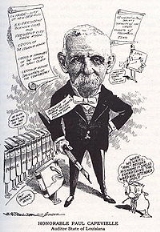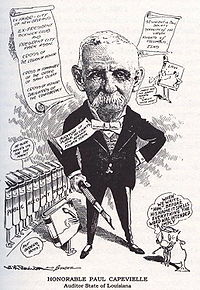
Paul Capdevielle
Encyclopedia
Paul Capdevielle was mayor of New Orleans
, Louisiana
, from May 9, 1900 to December 5, 1904.
 Of French
Of French
descent, he was educated at the Jesuit College of New Orleans, graduating in 1861. He served in the Confederate Army
in the American Civil War
, in the New Orleans Guard Regiment of Infantry
, then in Boone's Louisiana Artillery
. He was captured at Port Hudson
, Louisiana in July, 1863. Paroled shortly afterward, and subsequently exchanged, he entered Legardeur's artillery battery, and continued in the Confederate service till the close of the war, when he surrendered at Greensboro, North Carolina
, returning to New Orleans on foot. He read law at the Tulane University Law School
, graduating in 1868, and served as an attorney until 1892. In 1892 he gave up the law to accept the presidency of the Merchants' Insurance Company, an important firm which was eventually liquidated. For thirteen years Capdevielle was its president.
His political history began in 1877, when he was appointed to the State School Board by Governor Nicholls
. While he was a member of this body the entire state school system was reorganized and put into effective operation. Subsequently he was appointed a member of the New Orleans Levee Board
. In the election of 1900 he was the nominee of the Regular Democratic Organization; he won with 19,366 votes versus 13,099 for his predecessor Walter C. Flower
.
His tenure as mayor was marked by the installation of the modern sewage and drainage system and by the Robert Charles race riots
.
After his mayoral term, Capdevielle served as president of the New Orleans Public Library
Board and as State Auditor of Public Accounts. He is buried in St. Louis Cemetery No. 2
.
New Orleans, Louisiana
New Orleans is a major United States port and the largest city and metropolitan area in the state of Louisiana. The New Orleans metropolitan area has a population of 1,235,650 as of 2009, the 46th largest in the USA. The New Orleans – Metairie – Bogalusa combined statistical area has a population...
, Louisiana
Louisiana
Louisiana is a state located in the southern region of the United States of America. Its capital is Baton Rouge and largest city is New Orleans. Louisiana is the only state in the U.S. with political subdivisions termed parishes, which are local governments equivalent to counties...
, from May 9, 1900 to December 5, 1904.

France
The French Republic , The French Republic , The French Republic , (commonly known as France , is a unitary semi-presidential republic in Western Europe with several overseas territories and islands located on other continents and in the Indian, Pacific, and Atlantic oceans. Metropolitan France...
descent, he was educated at the Jesuit College of New Orleans, graduating in 1861. He served in the Confederate Army
Confederate States Army
The Confederate States Army was the army of the Confederate States of America while the Confederacy existed during the American Civil War. On February 8, 1861, delegates from the seven Deep South states which had already declared their secession from the United States of America adopted the...
in the American Civil War
American Civil War
The American Civil War was a civil war fought in the United States of America. In response to the election of Abraham Lincoln as President of the United States, 11 southern slave states declared their secession from the United States and formed the Confederate States of America ; the other 25...
, in the New Orleans Guard Regiment of Infantry
Infantry
Infantrymen are soldiers who are specifically trained for the role of fighting on foot to engage the enemy face to face and have historically borne the brunt of the casualties of combat in wars. As the oldest branch of combat arms, they are the backbone of armies...
, then in Boone's Louisiana Artillery
Artillery
Originally applied to any group of infantry primarily armed with projectile weapons, artillery has over time become limited in meaning to refer only to those engines of war that operate by projection of munitions far beyond the range of effect of personal weapons...
. He was captured at Port Hudson
Port Hudson, Louisiana
Port Hudson is a small unincorporated community in East Baton Rouge Parish, Louisiana, United States. Located about northwest of Baton Rouge, it is most famous for an American Civil War battle known as the Siege of Port Hudson.-Geography:...
, Louisiana in July, 1863. Paroled shortly afterward, and subsequently exchanged, he entered Legardeur's artillery battery, and continued in the Confederate service till the close of the war, when he surrendered at Greensboro, North Carolina
Greensboro, North Carolina
Greensboro is a city in the U.S. state of North Carolina. It is the third-largest city by population in North Carolina and the largest city in Guilford County and the surrounding Piedmont Triad metropolitan region. According to the 2010 U.S...
, returning to New Orleans on foot. He read law at the Tulane University Law School
Tulane University Law School
Tulane University Law School is the law school of Tulane University. It is located on Tulane's Uptown campus in New Orleans, Louisiana. Established in 1847, it is the 12th oldest law school in the United States....
, graduating in 1868, and served as an attorney until 1892. In 1892 he gave up the law to accept the presidency of the Merchants' Insurance Company, an important firm which was eventually liquidated. For thirteen years Capdevielle was its president.
His political history began in 1877, when he was appointed to the State School Board by Governor Nicholls
Francis T. Nicholls
Francis Redding Tillou Nicholls was an American attorney, politician, judge, and a brigadier general in the Confederate States Army during the American Civil War...
. While he was a member of this body the entire state school system was reorganized and put into effective operation. Subsequently he was appointed a member of the New Orleans Levee Board
Orleans Levee Board
From 1890 through 2006, the Orleans Levee Board was the body in charge of supervising the levee and floodwall system in Orleans Parish, Louisiana, which is intended to protect the city of New Orleans from flooding. The role included requirements definition prior to construction, operation, and...
. In the election of 1900 he was the nominee of the Regular Democratic Organization; he won with 19,366 votes versus 13,099 for his predecessor Walter C. Flower
Walter C. Flower
Walter C. Flower was the 44th mayor of New Orleans ....
.
His tenure as mayor was marked by the installation of the modern sewage and drainage system and by the Robert Charles race riots
Robert Charles Riots
The Robert Charles Riots of 1900 were sparked after African American laborer Robert Charles shot a white police officer, which led to a manhunt. Twenty-eight people were killed in the conflict, including Charles. Many more people were killed and wounded in the riots...
.
After his mayoral term, Capdevielle served as president of the New Orleans Public Library
New Orleans Public Library
The New Orleans Public Library is the public library service of the city of New Orleans, Louisiana, United States.-History:The system began in 1896 as the Fisk Free and Public Library in a building on Lafayette Square...
Board and as State Auditor of Public Accounts. He is buried in St. Louis Cemetery No. 2
Saint Louis Cemetery
Saint Louis Cemetery is the name of three Roman Catholic cemeteries in New Orleans, Louisiana. All of these graves are above ground vaults; most were constructed in the 18th century and 19th century....
.
External links
- Paul Capdevielle, Mayor (Kendall's History of New Orleans, Chapter 34)

